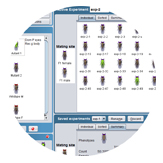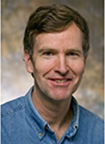 Dr. Scott Freeman
Dr. Scott Freeman
Title: Evidence-based Teaching in Introductory Biology
Seminar Date & Time: Wednesday, September 19, 2012 @ 1:00 pm
View the slides from Dr. Freeman’s Seminar
Listen to the audio from Dr. Freeman’s Seminar
Dr. Scott Freeman is a Senior Lecturer in Biology at the University of Washington (UW), where he teaches introductory and upper-division courses. Since the mid-1990s, his focus has been on textbook writing and teaching. He co-authors Evolutionary Analysis and is sole author of Biological Science; both texts are in their 4th edition. Dr. Freeman is also the recipient of a UW Distinguished Teaching Award. His research focuses on how active learning techniques impact student performance.
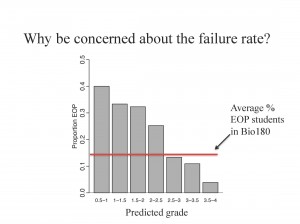
Figure 1. The predicted distribution of grades in Dr. Freeman's Bio180 class at the UW. The highest proportion of EOP students are predicted to receive the lowest grades in the course.
During his stimulating seminar entitled “Evidence-based teaching in introductory biology,” Dr. Freeman described his extensive work to incorporate evidence-based teaching methods to educate the next generation of biology experts. The goal of his work is to lower the failure rates in introductory biology courses and improve student learning of biological concepts. Dr. Freeman teaches a large, introductory biology course (UW course Bio180). The enrollment in the course has been increasing over time. While Dr. Freeman taught 340 students each quarter (approximately 1200 students each year) from 2000-2007, a typical enrollment since 2009 is 700 students each quarter (approximately 2100 student each year). This large enrollment constitutes approximately 40% of the all undergraduates at the UW. Teaching students introductory biology in such a large class setting while inspiring them in the life sciences is an astronomical and critical task.
Bio180 is the first of three introductory biology courses required at the UW for biology-related majors. The course consists mainly of sophomores, of which 61% are female and 39% male. In addition, 44.6% of students are white, 45.3% are Asian-American and international, and 8.4% are under-represented minorities. While 90% of the students intend to continue in graduate or professional programs, unfortunately 18.2% of the students in 2002 did not obtain a grade of 1.5 (on a 4.0 scale), which is necessary to advance to the next introductory biology course (Figure 2). Additionally, 44.8% of students in 2002 did not obtain the grade of 2.5 (on a 4.0 scale) to declare biology as a major (Figure 2). Not only was the overall failure rate very high, but Dr. Freeman also found that the 15% of students who are EOP (educational opportunity program) students, which consists of students from disadvantaged backgrounds, are more likely to fail introductory biology (Figure 1). Dr. Freeman set out to better understand this phenomenon to ultimately help the underprepared, but capable, students.
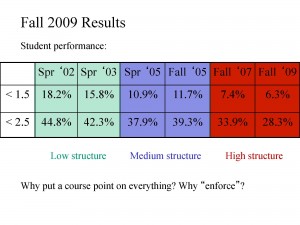
Figure 2. Dr. Freeman observed a significant drop in the failure rate when he implemented an active-learning centered course design.
Dr. Freeman first determined whether they can predict the students who will fail the course. He analyzed numerous factors, including gender, age, ethnicity, SAT scores, high school GPA, and UW GPA amongst others, to predict student grades in Bio180. He found that two factors: the SAT verbal score and UW GPA, when combined, were sufficient to predict student grades in his course. Dr. Freeman hypothesizes that the reason for this is that students with poor SAT verbal scores struggle with answering short answer questions and students with lower UW GPAs struggle with the higher-end thinking required in university courses.
Additionally, Dr. Freeman studied his course design to determine where he could implement changes to improve student learning of introductory biology. Prior to 2003, Dr. Freeman taught in a modified Socratic method in which he primarily lectured, but also interrupted lecture to randomly ask students questions. Starting in 2003, Dr. Freeman implemented 3-5 daily, active-learning exercises in addition to his modified Socratic teaching style. Dr. Freeman found that the failure rate decreased, albeit slightly to 15.8% of students having a grade less than 1.5 and 42.3% with a grade less than 2.5 (Figure 2). In 2005, Dr. Freeman started to enforce the daily active-learning exercises as well as implemented weekly, peer-graded practice exams. The spring of 2005 was the first time Dr. Freeman saw the proportion of students receiving lower than a 2.5 grade decrease (to 37.9%), as well as an increase in the median midterm grade (midterm was identical to Spring 2003) by 7 points (Figure 2). While the failure rate was heading in the right direction, Dr. Freeman continued to implement more active-teaching methods in the classroom. Specifically, he was interested in determining whether students at high risk of failing and EOP & under-represented minority students would benefit from even more structure in the classroom. To do this, Dr. Freeman implemented a “flipped classroom”, in which students read background material prior to coming to class and complete a daily reading quiz. Then, during class, Dr. Freeman does not lecture, but instead leads the class in completing approximately 4 clicker questions tailored to the students’ needs and misconceptions. Additionally, the students complete weekly practice exams. Dr. Freeman also tested whether students do better in the course when they work individually or in structured-groups to complete the weekly practice exams. He found that students at risk of failing do slightly better when working on their own, while high-performing students do better in structured groups. Most importantly, Dr. Freeman observed a dramatic decrease in the failure rate in this highly structured classroom (Figure 2). Now Dr. Freeman has taken this highly structured course design and successfully implemented it in classes of 700 students. And he lived to talk about it!
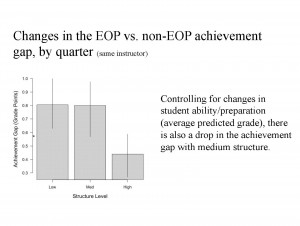
Figure 3. In the high-structure course, Dr. Freeman was able to significantly narrow the achievement gap between non-EOP and EOP students.
In order to reach valid conclusions, Dr. Freeman ensured that he controlled his studies for the quality of instruction, student ability and test question difficulty. There was no need to control for the instructor since Dr. Freeman was the sole instructor of the course during the entire period of the studies. Dr. Freeman analyzed the predicted student score during this time period. Lastly, Dr. Freeman had the test questions independently analyzed for Bloom’s taxonomy and difficulty level. He found that the predicted exam score slightly decreased from 70.6 (out of 100) in 2002 to 67.5 in 2009, indicating that they increased slightly in difficulty. The questions themselves were also independently analyzed for Bloom’s taxonomy level. He found that the exam questions required slightly more higher-order thinking in 2009 compared to 2002. From these analyses, Dr. Freeman ultimately concluded that the class itself was consistent (if not slightly harder) in difficulty level across the study. As a result, his findings that high-structure course design helps underprepared, but capable students, learn biology are even more significant.
By dramatically changing the classroom environment and adopting high-structure, active-learning teaching methods, Dr. Freeman observed a statistically significant decrease in the overall failure rate (Figure 2). More importantly, he found a statistically significant decrease in the failure rate of EOP students, and was able to reduce the achievement gap between EOP and non-EOP students (Figure 3). Dr. Freeman strongly believes that these dramatic results are due to the increase in the frequent problem-solving sessions during class and the peer-teaching that takes place in group learning sessions. It all boils down to Practice Practice Practice!

